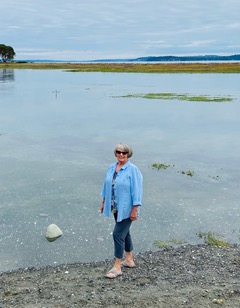Guest Blog by Jo Blair
 This was the third year I’ve attended UUA General Assembly – once in person and twice online – and the first time I was a delegate. The other two times I participated in GA, my goal was to learn from UUs involved in Native Social and Environmental Justice issues to inform the work of QUUF’s Native Connections Action Group. Although JUUstice Washington and UU Earth Ministry connect us to our regional and national faith community, I appreciated the opportunity to learn directly from Indigenous leaders from across the country at GA. I was drawn to a workshop on the Rights of Nature because Elliott Moffett, Nimiipuu (Nez Perce) activist, was on the panel.
This was the third year I’ve attended UUA General Assembly – once in person and twice online – and the first time I was a delegate. The other two times I participated in GA, my goal was to learn from UUs involved in Native Social and Environmental Justice issues to inform the work of QUUF’s Native Connections Action Group. Although JUUstice Washington and UU Earth Ministry connect us to our regional and national faith community, I appreciated the opportunity to learn directly from Indigenous leaders from across the country at GA. I was drawn to a workshop on the Rights of Nature because Elliott Moffett, Nimiipuu (Nez Perce) activist, was on the panel.
Rights of Nature are defined as a legal concept that describes inherent rights as associated with ecosystems and species, similar to the concept of fundamental human rights. The Rights of Nature concept challenges twentieth-century laws as generally grounded in a flawed frame of nature as a “resource” to be owned, used, and degraded.
The Rights of Nature session resonated on many levels. The Seventh Principle of Unitarian Universalism is “respect for the interdependent web of all existence of which we are a part.” Native Connections Action Group’s goals include being in solidarity to develop connections with Native peoples and to become aware of critical environmental issues affecting the very survival of Mother Earth and all her beings.
“The Rights of Nature: Who Speaks for the Earth?” was moderated by Rev. Dr. Clyde Grubbs, UU Minister of Texas Cherokee descent, and Aly Tharp, Director of UU Ministry for Earth. The panel members were Elliott Moffett, Board Member of Nimiipuu Protecting the Environment, and Casey Camp-Horinek, member of the Ponca Tribe of Oklahoma. Winona LaDuke, White Earth Ojibwe, was invited, but unable to participate, because she was on the front lines at Line 3 in northern Minnesota where Canadian oil company, Enbridge, is expanding its pipeline.
Do the Snake and Columbia Rivers have rights? Does the Salish Sea have rights? Do Salmon and Orca have rights? These questions and others occurred to me in 2018, on my way to the Snake River Flotilla with members of the North Olympic Orca Pod. After touring the Lower Granite Dam with its aging turbines, multimillion dollar fish slides and barges to transport salmon through the hot reservoirs above the dams, I was suddenly keenly aware that Nature was competing with the Army Corps of Engineers, Wheat Farmers, Barge Companies, and the Bonneville Power Administration, to name a few.
The Nimiipuu, Ponca, White Earth Ojibwe, Yurok, and other Tribes have signed resolutions declaring the Rights of Nature for their rivers and lands. They plan to use these resolutions to take legal action. As sovereign nations, the Tribes have Treaties with the US which include the right to consult with the US on a nation-to-nation basis.
Native Connections Action Group supports the Nimiipuu in their efforts to allow the Snake River to exist as a healthy ecosystem for Salmon and other species by breaching the Lower Snake River dams. This would permit wild Chinook salmon to spawn in the upper reaches of the Snake River and its tributaries in Idaho. Those Chinook salmon, in an interconnected web of life, will in turn provide sustenance to the Southern Resident Killer Whales who inhabit the Salish Sea.
Jo Blair is a native Washingtonian and member of the Chinook Indian Nation whose traditional lands are located on the shores where the Columbia River flows into the Pacific Ocean in Washington and Oregon. She has been a UU since the 1970s and joined QUUF in 2014. In the photo above, Jo is on the beach near the new bridge over the Marrowstone Passage at the south end of Kilisut Harbor close to high tide on a Saturday afternoon. Opening the estuary to enable it to flow freely is a project that exemplifies the Rights of Nature movement.

For .those interested, there is a classic 1972 publication
Should Trees Have Standing – Toward Legal Rights For Natural Objects, by Christopher Stone. It reviews the arguments for an against the rights of natural objects in the law suit brought before the Supreme Court in the Sierra Club v Morton Secretary Of The Interior. Justices Stewart, Burger, White, and Marshall upheld the no rights of natural objects over the decent of Justices Douglas, Brennan, and Blackman. This was an extremely important decision. In the publication Stone expands on the reasons natural objects should have legal rights. Worth your time.
Thank you Jo, for making the important connection between our UU faith and the rights of the natural world. Your passion, deep study and commitment inspire me. We are lucky to have you in our congregation.
Yay Jo! UUA offering some great workshops at GA. Good to know. Thanks.
Thanks Jo!
Yeah Jo – Love your thoughts! So important for the effort to change to the Dominance paradigm. Maybe we can talk and collaborate sometime.